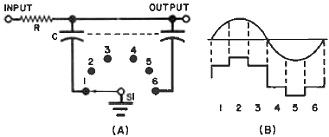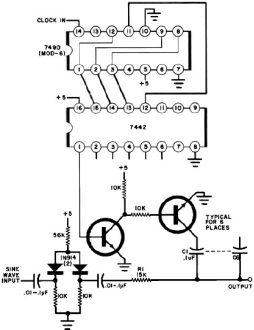Digital Filtering - Switched Capacitor Filters
|
|
When this Digital Filtering article appeared in a 1974 issue of Popular Electronics magazine, the concept of switched capacitor filters (SCFs) was just entering the realm of digital circuitry. One author, Carmen Parisi, credits none other than James Clerk Maxwell for initially contriving the idea. Today, variations of the switched capacitor filter are ubiquitously incorporated into integrated circuits of all sorts, but at the time of this piece they were assembled from discrete components including banks of capacitors, digital switches (counters), and transistors. Figure 2 shows an experimental circuit that uses six capacitor values for use at audio frequencies. The earliest IC switched capacitor filters worked in the hundreds of Hertz realm, and gradually increased in frequency until today they reach to around 100 kHz (see Digi-Key SCF offerings). New technique operates from a digital oscillator and uses no critical elements
Fig. 1 - At (A) is a simple switch circuit which generates the stepped waveform shown at (B) from a sine wave. By Leslie Solomon, Technical Editor Single frequency filters are important in a number of areas - RTTY, SSTV, radio control, etc. There are two approaches that are usually used to accomplish such filtering: either multi-element passive systems (which use precision components and are somewhat bulky physically) or active filters (which use a few passive components and an op amp). Even with the active filter, to obtain careful control of the selected frequency, it is necessary to select precision passive elements. Though either of the two approaches works well, there is a new filtering method that is unique and should be of interest to the serious electronics experimenter. Called digital filtering, the new method uses no critical elements and is "tuned" with a digital oscillator. High-Q filters (even at low audio frequencies) can be realized and the circuit is very stable since no regeneration is used. These filters use low-cost TTL logic and some conventional switching transistors. In the simple circuit shown in Fig. 1A, with the six-position switch in position 1, and with an audio sine wave applied to the input, the first capacitor will start to. charge up toward the signal's peak voltage. If S1 is switched to the next capacitor when the voltage across the first capacitor has reached the average value for that portion of the sine wave, the switch makes another step. Therefore, as S1 rotates around the six capacitors, each capacitor receives a charge whose value depends on the average value of the sine wave at its portion of the waveform. The charges on the capacitors can be represented by the step curve in Fig. 1B. Of course, the switch must be synchronized with the input sine wave. If the input and switching frequencies are not synchronized, the average voltages stored in each capacitor will differ and will drop very rapidly on each side of the switching frequency. This is the basis of digital filtering; and because of the synchronization system, tuning the filter to any desired frequency is primarily a matter of "tuning" the switching oscillator. Component values for the resistance and capacitance are not very critical. The circuit of an experimental digital filter for the audio range is shown. in Fig. 2. This circuit consists of a conventional mod-6 counter (7490) driving a BCD-to-decimal counter (7442). The audio input to be filtered is passed through a simple clipper and then coupled to the digital filter consisting of R1 and the six transistor-switched capacitors (C1 through C6). The digital logic and transistors form the switch in Fig. 1A. The digital clock that actually tunes the filter can be any variable-frequency triggering source at six times the required filter frequency. To tune the filter, connect the audio input to the clipper and a scope to the output. For a dual-channel scope, use the second channel to observe the sinewave input. Care must be taken in tuning the variable clock since the Q of the circuit is high and the filtering action might be missed. As the input is tuned up further in frequency, a peaking in the digitized waveform will be reached at the harmonics of the original setup, with the steps getting coarser each time. This will happen until the harmonic number corresponding to the number of switching positions is reached (six, in this case). There will then be no output, but there will be at the next harmonic. As each harmonic is viewed, it will be lower in amplitude and coarser. The filtered output signal is a distorted version of the original input so the output can not be used as a sine wave. However, it is useful for triggering other circuits. The bandwidth of the filter remains substantially the same even when the filter frequency is changed. Once built, to change the filter's center frequency, it is only necessary to change the clock frequency to the TTL counter (7490), with the frequency six times the input. The number of switched capacitors is not limited to six but can be any number from a minimum of three to as many as required. The larger the number of capacitors, the smoother the displayed waveform. The number of capacitors also determines the clock frequency. With six capacitors, the clock must be six times higher in frequency than the input. With five switched capacitors, the clock must be five times higher than the input signal, etc.
Posted July 22, 2022 |
|


